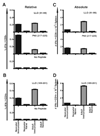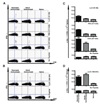Induction of protective immunity to Listeria monocytogenes in neonates
- PMID: 17339467
- PMCID: PMC2706399
- DOI: 10.4049/jimmunol.178.6.3695
Induction of protective immunity to Listeria monocytogenes in neonates
Abstract
Neonates suffer unduly from infections and also respond suboptimally to most commonly used vaccines. However, a CD8 T cell response can be elicited in neonates if the Ag is introduced into the cytoplasm of APCs. Listeria monocytogenes (Lm) targets the cytoplasm of APC and is a strong CD8 and CD4 Th1-promoting vaccine vehicle in adult mice. We hypothesized that an attenuated strain of Lm would be safe and induce long-lasting protective immunity, even in neonates. We found that neonatal mice immunized only once with the attenuated strain DeltaactA-Lm developed robust primary and secondary CD8 and CD4 Th1 responses and were fully protected from lethal challenge with virulent wild-type Lm without the need for a booster immunization. Furthermore, DeltaactA-Lm expressing a heterologous recombinant Ag induced a strong CD8 and Th1 memory response to that Ag. Based on these data, we propose that DeltaactA-Lm or derivatives thereof might serve as a vaccine vehicle for neonatal immunization.
Figures






References
-
- Siegrist CA. Neonatal and early life vaccinology. Vaccine. 2001;19:3331–3346. - PubMed
-
- Adkins B, Leclerc C, Marshall-Clarke S. Neonatal adaptive immunity comes of age. Nat. Rev. Immunol. 2004;4:553–564. - PubMed
-
- Li L, Lee HH, Bell JJ, Gregg RK, Ellis JS, Gessner A, Zaghouani H. IL-4 utilizes an alternative receptor to drive apoptosis of Th1 cells and skews neonatal immunity toward Th2. Immunity. 2004;20:429–440. - PubMed
-
- Adkins B, Bu Y, Guevara P. Murine neonatal CD4+ lymph node cells are highly deficient in the development of antigen-specific Th1 function in adoptive adult hosts. J. Immunol. 2002;169:4998–5004. - PubMed
Publication types
MeSH terms
Substances
Grants and funding
LinkOut - more resources
Full Text Sources
Other Literature Sources
Medical
Research Materials
Miscellaneous

